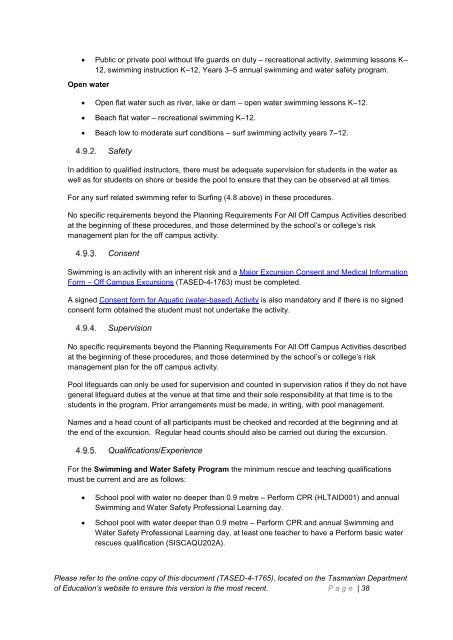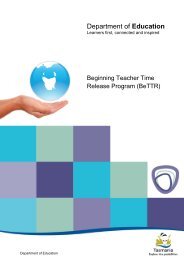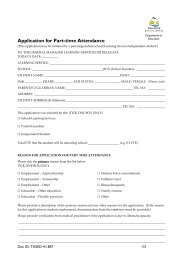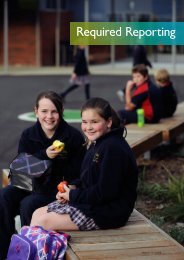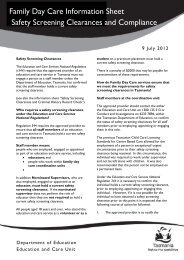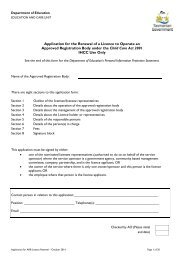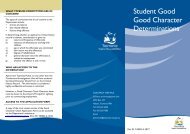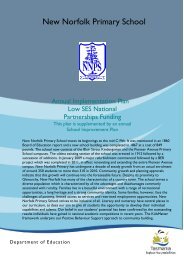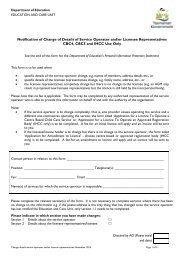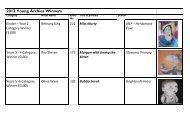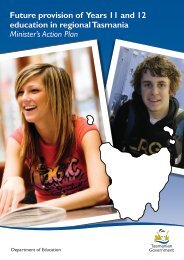PLANNING OFF CAMPUS ACTIVITIES
Procedures for Planning Off Campus Activities - Department of ...
Procedures for Planning Off Campus Activities - Department of ...
- No tags were found...
You also want an ePaper? Increase the reach of your titles
YUMPU automatically turns print PDFs into web optimized ePapers that Google loves.
Public or private pool without life guards on duty – recreational activity, swimming lessons K–<br />
12, swimming instruction K–12, Years 3–5 annual swimming and water safety program.<br />
Open water<br />
<br />
<br />
Open flat water such as river, lake or dam – open water swimming lessons K–12.<br />
Beach flat water – recreational swimming K–12.<br />
Beach low to moderate surf conditions – surf swimming activity years 7–12.<br />
Safety<br />
In addition to qualified instructors, there must be adequate supervision for students in the water as<br />
well as for students on shore or beside the pool to ensure that they can be observed at all times.<br />
For any surf related swimming refer to Surfing (4.8 above) in these procedures.<br />
No specific requirements beyond the Planning Requirements For All Off Campus Activities described<br />
at the beginning of these procedures, and those determined by the school’s or college’s risk<br />
management plan for the off campus activity.<br />
Consent<br />
Swimming is an activity with an inherent risk and a Major Excursion Consent and Medical Information<br />
Form – Off Campus Excursions (TASED-4-1763) must be completed.<br />
A signed Consent form for Aquatic (water-based) Activity is also mandatory and if there is no signed<br />
consent form obtained the student must not undertake the activity.<br />
Supervision<br />
No specific requirements beyond the Planning Requirements For All Off Campus Activities described<br />
at the beginning of these procedures, and those determined by the school’s or college’s risk<br />
management plan for the off campus activity.<br />
Pool lifeguards can only be used for supervision and counted in supervision ratios if they do not have<br />
general lifeguard duties at the venue at that time and their sole responsibility at that time is to the<br />
students in the program. Prior arrangements must be made, in writing, with pool management.<br />
Names and a head count of all participants must be checked and recorded at the beginning and at<br />
the end of the excursion. Regular head counts should also be carried out during the excursion.<br />
Qualifications/Experience<br />
For the Swimming and Water Safety Program the minimum rescue and teaching qualifications<br />
must be current and are as follows:<br />
<br />
<br />
School pool with water no deeper than 0.9 metre – Perform CPR (HLTAID001) and annual<br />
Swimming and Water Safety Professional Learning day.<br />
School pool with water deeper than 0.9 metre – Perform CPR and annual Swimming and<br />
Water Safety Professional Learning day, at least one teacher to have a Perform basic water<br />
rescues qualification (SISCAQU202A).<br />
Please refer to the online copy of this document (TASED-4-1765), located on the Tasmanian Department<br />
of Education’s website to ensure this version is the most recent. P a g e | 38


